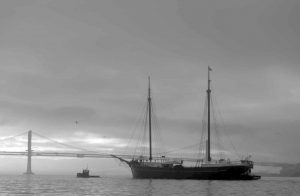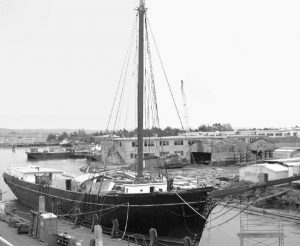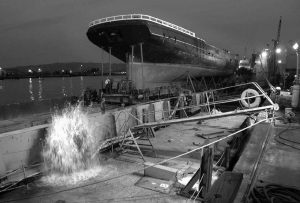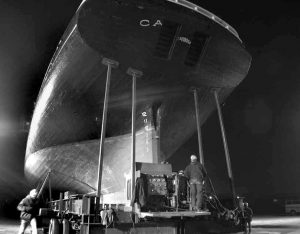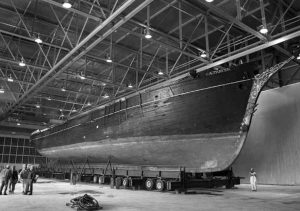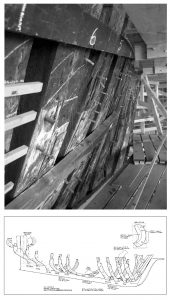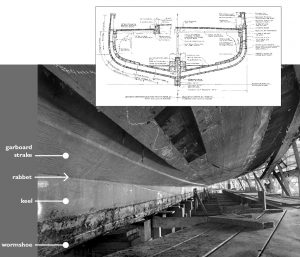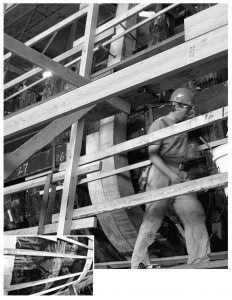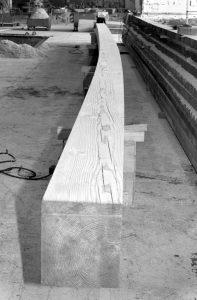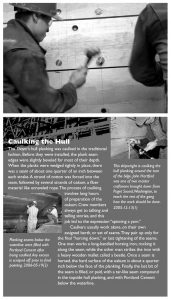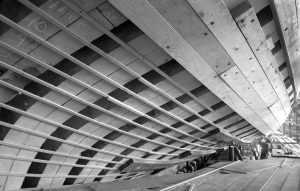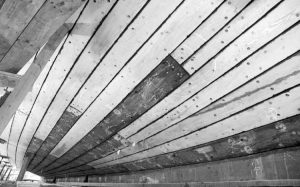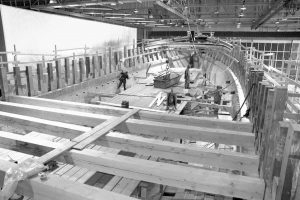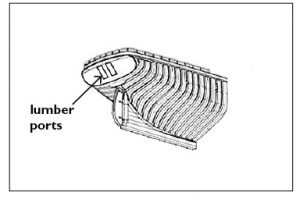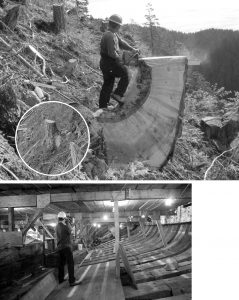By Stephen Canright
Excerpt from the Sea Letter, 2007, No. 68
The scale of the work on the West Coast lumber schooner C.A. Thayer is without precedent in the history of maritime preservation. The Thayer, 168 feet long on deck and registered at 452 gross tons, will emerge with more than 85 percent of her hull fabric replaced. This is easily the largest wooden merchant shipbuilding project completed in the United States since the 1920s. The end-point is not a new vessel duplicating the original, but rather the original renewed, with the strength to float for another century.
As early as the late 1970s, when the National Park Service took over the Thayer, her hull was fatally weakened with dry rot in the upper frame timbers. Douglas fir is a lovely shipbuilding timber, but it is a softwood and is famously susceptible to rot. The traditional structure of a wooden ship, with the frames encased between the outer hull planking and the inner ceiling planking, is an ideal breeding ground for rot. When rainwater finally seeps into the structure, the frames stay wet and rot takes hold.
The softening of the Thayer’s frame timbers left her ever more susceptible to hogging, another killer of traditional wooden vessels. Hogging occurs when the ends of the hull droop down in relation to its midpoint, bending the keel into an arc. The ends, as they narrow at the bow and stern, have less buoyancy than the wider midbody, and are effectively heavier. Over the years, the weight differential takes its toll and the bow and stern sag. Any large wooden hull will hog to some extent, but West Coast schooners like the Thayer are particularly prone to hog. Designed with relatively shallow hulls to cope with the offshore sandbars of West Coast ports, the schooners had less effective longitudinal girder strength than the deeper, narrower hulls of the East Coast square-riggers. The Thayer was profoundly hogged, and something had to be done.
One of our objectives in the rebuild was to return the vessel to her as-built configuration, reversing changes made to her deck, cargo hatches, and deckhouse over the years. Our assumption was that she was best presented as a representative of the West Coast lumber fleet, seen as her designer and builder had intended.
While the Thayer was being stripped and lightened, preparations for hauling her out began. A steel cradle was welded together on the floor of the Bay Ship dry dock. This massive pallet of steel I-beams would hold the hull, braced with steel struts, throughout the rebuilding process.
With the cradle finished and sitting in the dry dock, the dock was flooded and the hull was towed in. Divers helped to spot the keel directly on the centerline blocking, and locate it precisely fore and aft. The blocks were set to accommodate 12 inches of hog, 4 inches fewer than the 16 inches actually measured in her keel. This was the first real bit of restoration. The first 4 inches of bend were straightened out of the hull as she settled onto the blocks.
With the dock pumped dry, the vessel rested on the cradle. Bilge blocks from the dock floor held her steady until steel support struts were welded to the cradle. The next challenge was to pick up and move the cradle and hull as a single unit. Sixteen house-moving dollies were hoisted into the dock and slipped under the cradle. Each of the dollies was fitted with hydraulic jacks, and four of them also had propulsion and steering systems, so that the cradle and hull could be both lifted and driven slowly ahead.
A square-ended barge was positioned at one end of the dry dock, and the cradle was slowly driven onto the barge. Next morning at high water, about 3:00 am, the barge was towed around the tip of Alameda to the edge of the old main runway at the former Alameda Naval Air Station, where it was brought ashore.
With the steel cradle blocked solidly on the hangar floor, the first step was to make a laser scan of the hull. This was done for documentation purposes, rather than as a guide for the reconstruction. As the project went ahead, all of the new timbers would be patterned directly from the hull, not from any drawings. It would certainly have been quicker to rebuild her from a crisp new design drawing, but this way of working — replacing deteriorated material piece by piece — ensured that the Thayer was in fact rebuilt rather than replicated. We were doing ship repair on off, we got our first look at the framing timbers of the vessel. All of the deck beams showed some rot, and all would ultimately be replaced.
Rebuilding a wooden ship requires a ruthless approach to cutting away material to get at the underlying frame timbers. The bulwarks were cut off in 8-foot lengths. We then started on the topside hull planking — the hull planking above the waterline. We knew that this planking was largely rotten and consisted mostly of replacement planks. We could identify the few remaining original planks because they were fastened with trunnels (long dowels made of locust wood), which were originally used to fasten all hull planking. We carefully noted how these planks were fastened. We sacrificed the topside hull planking with a relatively easy mind.
We were much less eager to scrap the wider bottom hull planking, much of which was in 80 and 90-foot lengths. Fortunately, we were to find that both the planks and the frame timbers in the bottom were in generally good condition, having always been soaked in salt water. Dry rot does not grow in salt water, and this was the very thing that made the Thayer job possible — we were able to build up from a foundation of sound original material in the bottom frame, keel, and planking. Had these timbers been rotten, we would have had to write off the whole vessel and start from scratch.
With the topside and main deck planking stripped off, the hull was as limber as it was going to get, and we turned to the job of settling out the remaining 12 inches of hog in the keel. The idea was that the keel could be straightened by just the weight of the hull, backing down on jacks and wedges in a smooth and controlled fashion. The keel, in fact, came down easily and quickly. After only six hours, the keel was dropped to a level line of blocks.
We were surprised, however, to see that, even with the bottom of the keel leveled, almost 4 inches of arc remained in the line of the rabbet — the joint between the keel and the lowest hull plank. We determined that there were two separate things going on. First, the forward 40 feet of the 4-inch wormshoe (a sacrificial plank on the end of the keel that takes abrasion from grounding or attack by worms), was missing, allowing the forward end of the keel to sag. The forward wormshoe had probably been missing since 1903, when she grounded at Grays Harbor, Washington. The fix was easy enough. The forward part of the keel was jacked up and a new wormshoe section installed (see illustration).
Even with the bow raised this much, however, there was still about 3 inches of arc in the line of the rabbet. We had to lower the midship blocking by 3 inches to straighten out the rabbet. The only explanation was that the vessel had been built with a bit of spring-loading against the hogging that was certain to arise when the hull was first floated. The first bit of hogging deformation would have actually bent the keel back toward a straight line. Then, as at several other points, we would stand back and marvel at the ingenuity of the original designers and builders.
With the hull blocked to its approximate shape, the work of replacing rotten frame timbers could begin. The first step was to install ribbands along the hull. Ribbands are long wooden battens, about 2½ inches by 1 inch, by at least 40 feet long. These were screwed to the outer surface of the frames with drywall screws, their upper edges landing, as nearly as possible, on the seams of the old topside hull planking. The inner surface of the ribbands stood in for the hull planking. The shape of each piece of frame timber to be replaced could be patterned from the space between the ribbands outside and the ceiling planking inside.
The renewal of the frame timbering began with the designation of every fifth frame as a “station” frame. The process of reframing was worked out in the course of renewing the station frames, beginning with Frame #25 on the star-board side.
Through most of the length of the hull, the new upper futtocks could be joined to sound existing lower timbers. We had to remove most of the inner ceiling planking in order to get at these lower frame timbers. This “thin ceiling,” below the turn of the bilge, was 4 inches thick. For the most part, it was not in bad condition, but had to be sacrificed. We preferred to cut out the thin ceiling rather than the outer bottom planking. The thick upper ceiling planking, running through the turn of the bilge and up to just under the main deck, was temporarily left in place during the re-framing process to serve as a pattern for the hull shape. It was entirely rotten, however, and was eventually replaced.
It was only in the ends of the hull that the lower sections of the framing timbers were rotten and had to be replaced. Over the years, fresh water had sometimes pooled in these sections and rot had taken hold. We ended up removing and replacing the bottom timbers of the last four full frames in both the bow and the stern. To do this, we had to remove portions of the lowest strake of bottom planking — the garboard strake — and sections of lower sister keelson timbers fore and aft.
Dealing with the keelsons proved a tricky proposition. Six keelson timbers, each about 18 inches square, run down the centerline of the hold, strongly fastened with steel drift rods to the upper surfaces of the frame timbers. This stack of heavy timbers is a vital strength member in the hull, and helps the keel resist bending. The timbers are in lengths of at least eighty feet, with long scarf joints between the segments.
The degree of rot in the keelsons was not immediately evident. We could see that there were pockets of softness around the steel drifts due to rusting iron that was poisoning the surrounding wood. This degree of weakness we were prepared to live with, but these soft spots might well have allowed freshwater intrusion deeper into the timbers, making for deep, hidden rot pockets. We decided, in the end, to remove the whole of the upper sister keelsons on either side. The lower sister keelsons looked good, and we would have left them undisturbed, except for the need to get at the lower frame timbers in the very ends.
The centerline timbers of the bow and stern showed serious pockets of rot, and had to be replaced. The stem post, the heavy vertical timber in the very bow, had been partially replaced in 1961, but the top of the original lower section was now rotten. This timber, together with the apron timber that backs it up, was replaced as a single piece as per the original design.
The structure of the stern of the Thayer was a weak point in the original design. The location of the stern timber ports, which are immediately alongside the stern post, left no room for longitudinal horn timbers, which normally stiffen up the overhang of the stern. As designed, the stern got much of its strength from the heavily reinforced bulwark structure and the framing of the raised poop deck. Unfortunately, this bulwark structure had been weakened by hasty repair work done in the 1950s and by rot in the intervening years. By the time of the rebuild, the stern overhang had sagged off by about 6 inches.
In the end, we largely restored the designed strength of the stern overhang and the transom. A new upper section of stern post, new rudder trunk, strong quarter knees, and full ceiling planking were installed inside the after section of the bulwarks. The shape of the upper portion of the transom, which had been shortened when the U.S. Army had the vessel in the 1940s, was returned to its original configuration.
While the work of framing was still ongoing, the main deck beams and framing were pulled out. Before the beams came out, temporary cross-spalls were fastened across the thick ceiling planking to prevent the hull from spreading.
The main deck beams under the after-house were generally in good shape, and the basic structure of the afterhouse retained a fair degree of integrity. We were certainly not eager to dismantle it, but we needed to get at the after portion of the interior of the hull. Bay Ship came up with a very clever approach to the problem: the whole after-house, including the deck beams, was lifted on steel I-beams and supported above the hull on steel pillars while the work below was accomplished.
As the main deck beams were removed, we were able to assess the condition of the hanging knees. These knees, joining the deck beams to the hull sides, are vital strength members in a traditional wooden hull. They are particularly interesting because they are the only timbers in the hull that are grown shapes, rather than sawn to shape out of straight-grained material. Hanging knees represent a tremendous amount of labor, since knees are cut out of the upper roots of fir trees, preferably the uphill root of trees growing on a steep hillside. These knees are dense-grained material that is much more resistant to rot than normal fir. We were able reuse all but about four of the Thayer’s fifty original hanging knees.
By late 2004, one year into the project, the bulk of the new framing was in place and much of the original strength of the hull was re-established. We were now able to remove the diagonal pointer timbers, which helped to strengthen the bow and stern, and to finally remove the thick ceiling planks fore and aft.
The 8-inch thick ceiling planking forms an immensely strong structure within the hull. This additional longitudinal stiffness is the only reason that the shallow West Coast lumber schooner hulls worked as well as they did. In order to get every bit of stiffness out of the thick ceiling structure, the heavy planks were scarf-jointed between the planks within each strake and edge-fastened through each plank into the plank below. The result was a single, complexly shaped girder within the hull, able to provide critical resistance to bending stress in exactly the area that rigidity was most needed.
We were able to replace the thick ceiling with essentially the same material, with 80-foot lengths of magnificent 8-inch fir through the middle of the hull. As in the original design, the bow and stern sections of the ceiling were laid in two layers of 4-inch plank, which is better able to meet the extremes of bend and twist in these areas than are 8-inch planks. The ceiling planks were fastened to the frames with heavy steel drifts, and edge-fastened between the strakes.
Once the ceiling was in, our attention turned to the sheer clamp timbers. These are the members that run fore and aft along the top of the ceiling planking, and provide the shelves for the ends of the deck beams to land on. The clamp timbers are essential longitudinal strength members and define the sheer line of the hull. The middle sections of the original clamps were single timbers 114 feet long, 12 inches thick, by 14 inches high. For the replacement clamps, we were limited by the availability of materials to maxi-mum timber lengths of 42 feet, and so had to introduce extra scarf joints into the structure on both port and starboard. Otherwise, we were able to follow the original construction.
With the thick ceiling and the sheer clamps in place, the planking of the hull could begin. The Thayer is entirely planked in 4-inch-thick fir, with the single exception of the garboard strakes, which are 6 inches thick.
In planning the hull planking, we were forced to make adjustments in the original planking runs to suit the widths of the planking material available to us. The process of laying out the planking runs is called lining off a hull. The runs of the planking were marked on the hull framing by re-positioning the ribbands to reflect the new lining pattern. As a part of the fairing process, a flat spot, or facet, was planed into the frame so that the flat back face of the plank would bear solidly against the frame.
A full-sized pattern was made up in light plywood for each plank section, and the plank, with its proper taper and edge bevel was cut out on the ship saw. Many of the planks were more than 80 feet long. The plank sections at the ends of the vessel were steamed to make them pliable enough to take the extreme curve and twist.
While the hull planks were going on, part of the gang turned to installation of the main deck framing. All of the deck beams ended up being replaced. After considerable discussion about the camber of the main deck, we decided that the centerline should be 3½ inches higher than the deck edge. While the Thayer showed a lot of variation in camber over her length, we decided to go with the measurement taken at the beam at the forward edge of the afterhouse. We reasoned that the afterhouse front timbers, stacked above this beam, would have prevented any significant changes from the original designed configuration.
Another question on the beam layout was: to what degree were the beams de-signed to be lifted along the centerline by the stanchions? We finally decided to allow about three-quarters of an inch of arc to be bent into the bottoms of the deck beams — just enough to tension the structure without putting too much strain on the fastenings holding the deck beam ends down to the sheer clamps. The rest of the arc required to form the camber was sawn into the top surface of the beams. Most of the beams were 14 inches in sided, or fore-and-aft, dimension, by about 12 inches in depth amidships. Heavier beams, 16 inches wide, were used at the ends of the two cargo hatches.
The deck framing work included laying in the carlins, which are the fore-and-aft timbers framing either side of the cargo hatches. The hatches were returned to their original configuration, with both main and fore hatches spanning four beams. Three half-beams connected the sides of each of the carlins with the side of the hull. The half-beams were stiffened up with four lodging knees on each side of each hatch, all fastened with heavy drift bolts.
The afterhouse, which had been raised up on temporary steel pillars, was now dropped back down, with the ends of the original deck beams resting on the new sheer clamp. New ends were scarfed on the ends of two of the starboard beams to eliminate localized rot.
With the deck beams in place, attention turned to the deck edge structure. The first step was the installation of blocking between the ends of the out-board ends of the deck beams as they lay on the sheer clamps. The blocks fit tightly between the beams, and were fastened down into the shear clamps with headed drifts, holding the beams against any fore-and-aft movement.
The next major job was the installation of the waterway timbers. These heavy planks, finishing 7 inches in thickness by 11 inches in width, run along the perimeter of the deck, just inside the bulwark stanchions, from the stem post to the transom. The individual lengths of water-way timbers are joined together by long scarf joints. The waterways are vital in establishing the strong upper rim of the hull girder. In the original hull, the waterways were laid in lengths of 80 feet or better, but in replacing them, we were limited to 42-foot lengths. This had to be very high quality material to resist its exposed position on the exposed deck. The waterway timbers could not be bent, but rather were sawn to shape out of wider stock. In the bow of the vessel, where the curves are most extreme, the 11-inch finished pieces were cut out of 7-inch stock, 24 inches wide. For maximum strength, the water-way timbers were notched over the deck beams and into the bulwark stanchions that rise above main deck level. This made it a very tricky piece to fit.
With the waterways in place, the laying of the main deck planking got underway. The deck planking was 4 x 4-inch material, most of it in lengths of 40 feet. This was, again, very fine material — vertical, tight-grained fir with virtually no knots. A standard caulking bevel was planed into one edge as the planks were initially milled out. The first of the planking was laid down along the centerline of the deck, and was then worked toward either side.
As the main deck planking began to go down, the reconditioned hanging knees were installed under the deck beams. The knees were fastened per the original design, with about a dozen heavy drifts driven from the inside.
The caulking of the main deck planking began even before the deck was fully laid. The process was similar to the caulking of the hull planking, except that the seams were paid with hot marine glue, a tar-like pine resin material.
The new main deck planking had to link up with the original planking inside the afterhouse. The old sill timber, which formed the forward face of the base of the afterhouse, was quite rotten and was cut out. This allowed us to join the new deck to the old in a well-staggered butt pattern. Once this area of the deck was caulked and paid, a new sill timber was shaped and installed.
With the hull planked and caulked, and the main deck laid and caulked, the funding for the project was almost gone. We would be able to pay for painting and re-launching the vessel, but it looked like we could not afford to fund several major work items. The largest of these items was the bulwark planking (the continuation of the hull planking above the main deck level). In the end, funding for the planking came through from the Regional Cultural Resources program. The bulwark planking ultimately went on in very good style.
We were seriously contemplating launching the vessel without the rail cap, the 5-inch timber that tops the bulwark and lends its bit of longitudinal strength to the upper hull structure. However, the decision was finally made to hold the vessel in the hangar into the 2007 fiscal year and to use Maritime Park base funding to pay for the rail cap and various other finishing projects.
The Thayer will emerge from her hangar watertight and ready to float. She will, however, be far from complete. There will be no forward house, no taffrail around the stern, no fancy carved beakhead, no masts or rigging, and no internal bulkheads or accommodation decks. The diagonal pointers, the upper sister keelsons, and the remainder of the thin ceiling planks will have to be put in at a later time. She will not be properly ballasted, and will have only temporary bilge pumping and electrical systems. Yet with all of this work deferred, and the vessel only partially open to the public upon her return to Hyde Street Pier, we can still look at the project thus far with a good deal of pride.
Click Image for Larger Picture

